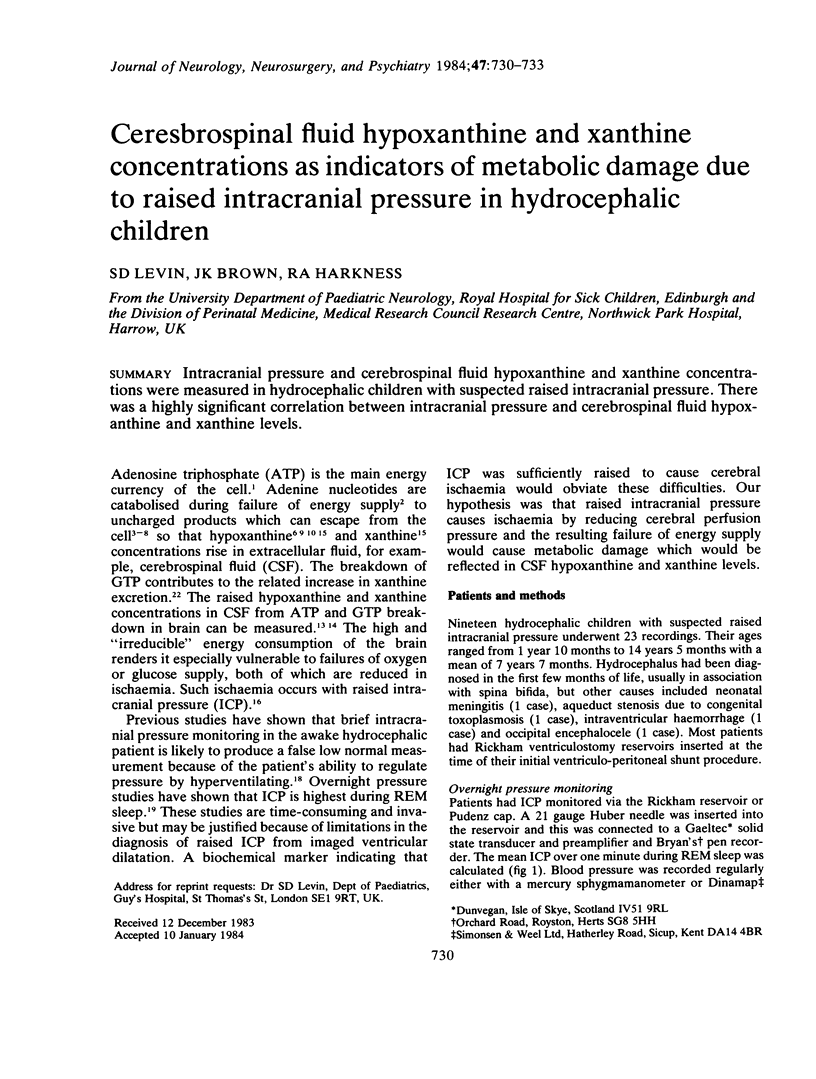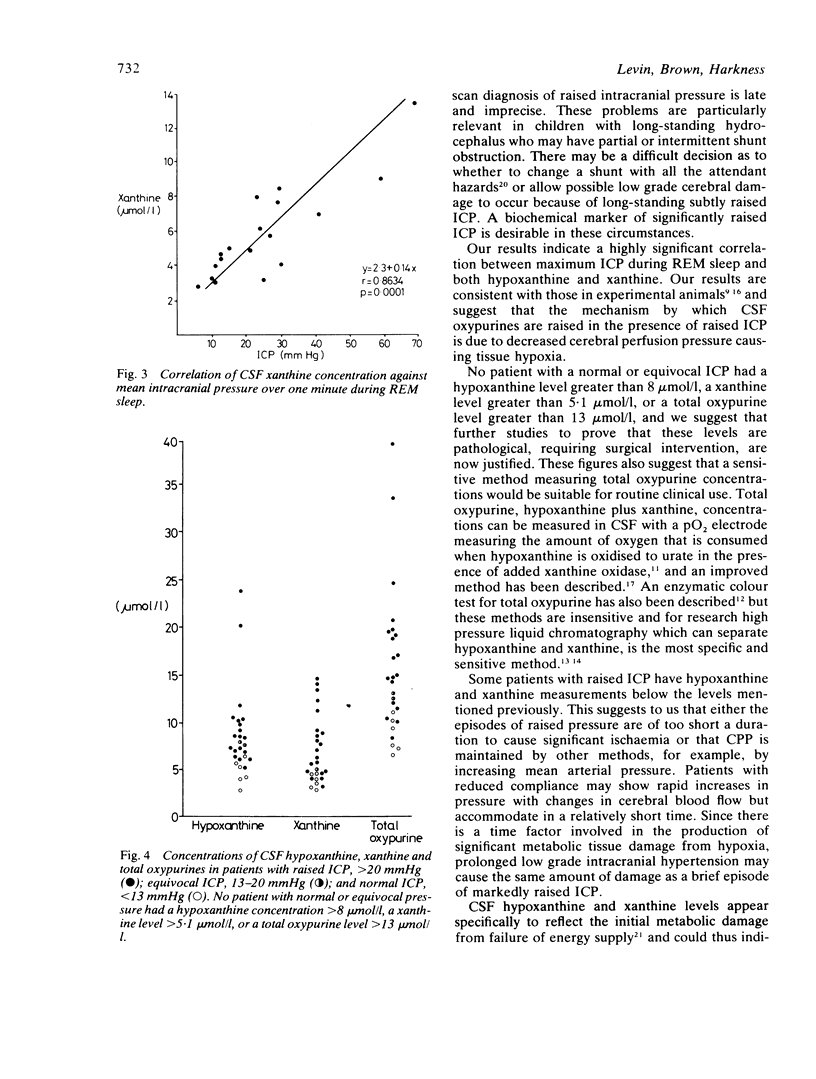Abstract
Intracranial pressure and cerebrospinal fluid hypoxanthine and xanthine concentrations were measured in hydrocephalic children with suspected raised intracranial pressure. There was a highly significant correlation between intracranial pressure and cerebrospinal fluid hypoxanthine and xanthine levels.
Full text
PDF



Images in this article
Selected References
These references are in PubMed. This may not be the complete list of references from this article.
- BERNE R. M. Cardiac nucleotides in hypoxia: possible role in regulation of coronary blood flow. Am J Physiol. 1963 Feb;204:317–322. doi: 10.1152/ajplegacy.1963.204.2.317. [DOI] [PubMed] [Google Scholar]
- Deuticke B., Gerlach E., Dierkesmann R. Abbau freier Nucleotide in Herz, Skeletmuskel, Gehirn und Leber der Ratte bei Sauerstoffmangel. Pflugers Arch Gesamte Physiol Menschen Tiere. 1966;292(3):239–254. [PubMed] [Google Scholar]
- Drewes L. R., Gilboe D. D., Betz A. L. Metabolic alterations in brain during anoxic-anoxia and subsequent recovery. Arch Neurol. 1973 Dec;29(6):385–390. doi: 10.1001/archneur.1973.00490300047005. [DOI] [PubMed] [Google Scholar]
- Harkness R. A., Simmonds R. J., Coade S. B., Lawrence C. R. Ratio of the concentration of hypoxanthine to creatinine in urine from newborn infants: a possible indicator for the metabolic damage due to hypoxia. Br J Obstet Gynaecol. 1983 May;90(5):447–452. doi: 10.1111/j.1471-0528.1983.tb08942.x. [DOI] [PubMed] [Google Scholar]
- Harkness R. A., Simmonds R. J., O'Connor M. C., Webster A. D. Purine metabolism studied with high-pressure liquid chromatography [proceedings]. Biochem Soc Trans. 1979 Oct;7(5):1021–1022. doi: 10.1042/bst0071021. [DOI] [PubMed] [Google Scholar]
- Maaser M., Schramm D., Scheidt B., Frenzel J. Methodischer Beitrag zur Bestimmung von Hypoxanthin im serum als Hypoxieparameter bei Neugeborenen. Kinderarztl Prax. 1979 Aug;47(8):408–413. [PubMed] [Google Scholar]
- Manzke H., Spreter von Kreudenstein P., Dörner K., Kruse K. Quantitative measurements of the urinary excretion of creatinine, uric acid, hypoxanthine and xanthine, uracil, cyclic AMP, and cyclic GMP in healthy newborn infants. Eur J Pediatr. 1980 Mar;133(2):157–161. doi: 10.1007/BF00441585. [DOI] [PubMed] [Google Scholar]
- Meberg A., Saugstad O. D. Hypoxanthine in cerebrospinal fluid in children. Scand J Clin Lab Invest. 1978 Sep;38(5):437–440. doi: 10.1080/00365517809108448. [DOI] [PubMed] [Google Scholar]
- Nordström C. H., Rehncrona S., Siesjö B. K., Westerberg E. Adenosine in rat cerebral cortex: its determination, normal values, and correlation to AMP and cyclic AMP during shortlasting ischemia. Acta Physiol Scand. 1977 Sep;101(1):63–71. doi: 10.1111/j.1748-1716.1977.tb05984.x. [DOI] [PubMed] [Google Scholar]
- Olsen L., Frykberg T. Complications in the treatment of hydrocephalus in children. A comparison of ventriculoatrial and ventriculoperitoneal shunts in a 20-year material. Acta Paediatr Scand. 1983 May;72(3):385–390. doi: 10.1111/j.1651-2227.1983.tb09733.x. [DOI] [PubMed] [Google Scholar]
- Pierre-Kahn A., Gabersek V., Hirsch J. F. Intracranial pressure and rapid eye movement sleep in hydrocephalus. Childs Brain. 1976;2(3):156–166. doi: 10.1159/000119611. [DOI] [PubMed] [Google Scholar]
- Saugstad O. D. Hypoxanthine as an indicator of tissue hypoxia. A study of plasma, cerebro-spinal and brain tissue concentrations. J Oslo City Hosp. 1977 Mar;27(3):29–40. [PubMed] [Google Scholar]
- Saugstad O. D., Schrader H., Aasen A. O. Alteration of the hypoxanthine level in cerebrospinal fluid as an indicator of tissue hypoxia. Brain Res. 1976 Aug 6;112(1):188–189. doi: 10.1016/0006-8993(76)90349-8. [DOI] [PubMed] [Google Scholar]
- Saugstad O. D. The determination of hypoxanthine and xanthine with a PO2 electrode. Pediatr Res. 1975 Jul;9(7):575–579. doi: 10.1203/00006450-197507000-00004. [DOI] [PubMed] [Google Scholar]
- Simmonds R. J., Harkness R. A. High-performance liquid chromatographic methods for base and nucleoside analysis in extracellular fluids and in cells. J Chromatogr. 1981 Dec 11;226(2):369–381. doi: 10.1016/s0378-4347(00)86071-5. [DOI] [PubMed] [Google Scholar]
- Winn H. R., Rubio R., Berne R. M. Brain adenosine production in the rat during 60 seconds of ischemia. Circ Res. 1979 Oct;45(4):486–492. doi: 10.1161/01.res.45.4.486. [DOI] [PubMed] [Google Scholar]



